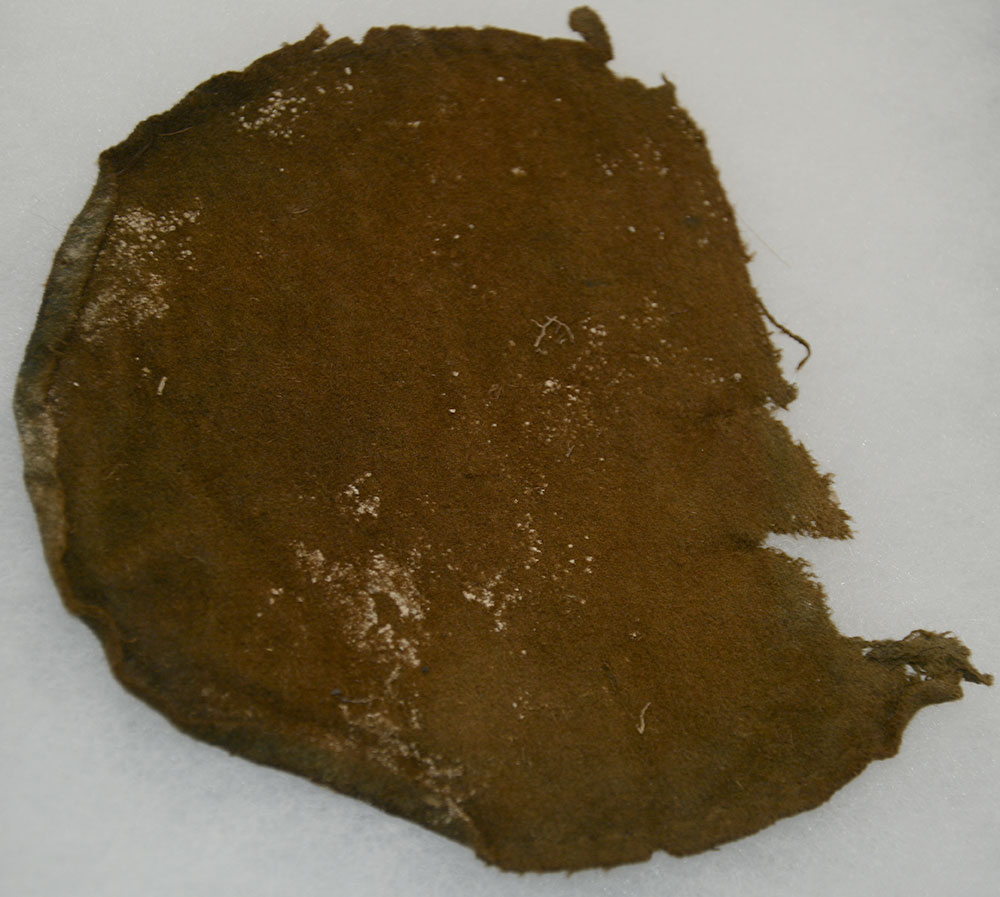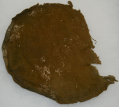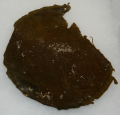site search
online catalog
KEPI CROWN FROM AN INDIAN WARS US ARMY FRONTIER FORT

$75.00 SOLD
Quantity Available: None
Item Code: 1052-433
This relic from Fort Pembina, ND, is about two-thirds of the crown of a soldier’s kepi. The color has shifted from blue to an olive brown, a little darker on one side than the other, and shows white stains and some small holes, but is solid and displayable. The edge shows some lighter color in places from having been protected by the sides of the cap that extend above it and were rolled over around its edge to create an inset crown.
Situated in the Red River Valley in North Dakota near the Canadian border, Fort Pembina was established in 1870 and in operation until 1895. Trading posts existed earlier in the area as part of the fur trade, and the first U.S. military post there was temporary- manned by a detachment of Minnesota troops in 1863-1864 following the 1862 Sioux uprising. In March 1870 a new fort was established south of the Pembina River and about 200 yards west of the Red River, completed by July and named in honor of Gen. George H. Thomas. The name was changed to Fort Pembina in September and the initial garrison consisted of two companies of the 20th US Infantry. Their main duty was to provide security for settlers worried about Sioux returning south from Canada, escort boundary surveys along the Canadian border, and, ironically, prevent raids north into Canada by Fenian groups.
The fort included enlistedmen’s barracks, officers’ quarters, guard house, ordnance storehouse, company kitchen, root house, laundress’s quarters, quarters for civilian employees, hospital and hospital servant’s house, a barn for the “hospital cow,” quartermaster and commissary offices and storehouse, stables, wagon shed, etc. The garrison reached peak strength in 1878 of 200, but the average was about 125 enlisted men and 8 officers. An October 1885 return listed 97 men, 2 field pieces, 1 mountain howitzer, 100 rifles, 19 pistols, 23 mules, and 9 wagons. By 1890 the post had just 23 men, and after an 1895 fire destroyed some 19 buildings it was decided to abandon the fort rather than rebuild, the last detachment left in September. The property was turned over to the Interior Department and later sold in 1902.
As would be expected from an early Indian War post, relics recovered there are a mix of Civil War commercial and issue items retained by soldiers, sold by retailers from old inventory, or issued by the army out of surplus stocks, along with later material, both commercial and issue. The excavations were conducted on private property with the owner’s permission, and the soil conditions have preserved both leather and cloth in remarkably good condition. [sr][ph:L]
~~~~~~~~~~~~~~~~~~~~~~~~~~~~~~~~~~~
THIS ITEM, AS WITH ALL OTHER ITEMS AVAILABLE ON OUR WEB SITE,
MAY BE PURCHASED THROUGH OUR LAYAWAY PROGRAM.
CLICK HERE FOR OUR POLICIES AND TERMS.
THANK YOU!
Inquire About KEPI CROWN FROM AN INDIAN WARS US ARMY FRONTIER FORT
For inquiries, please email us at [email protected]
Most Popular
Historical Firearms Stolen From The National Civil War Museum In Harrisburg, Pa »
Theft From Gravesite Of Gen. John Reynolds »
Cavalry Carbine Sling Swivel »
Fine Condition Brass Infantry Bugle Insignia »
featured item
CIVIL WAR COMMERCIAL FORAGE CAP WITH MAINE BUTTONS AND ASSOCIATED INSIGNIA
Commercial caps were simply those purchased privately rather the issued by the government. They might more or less closely follow contract patterns with the purchaser able to suit his taste and wallet, though an enlisted man, seeking something nicer… (1052-139). Learn More »




